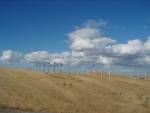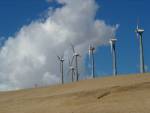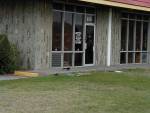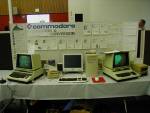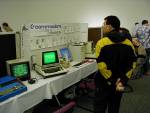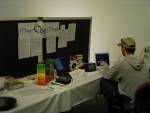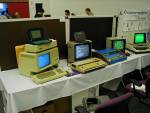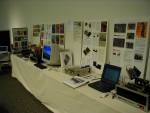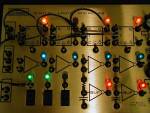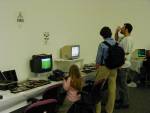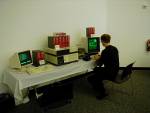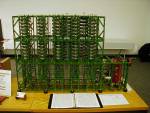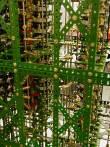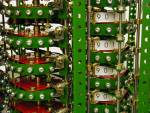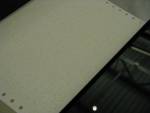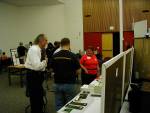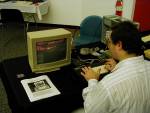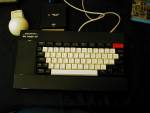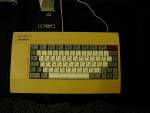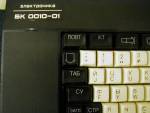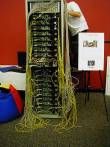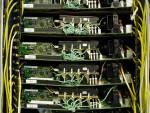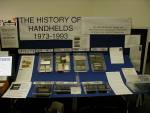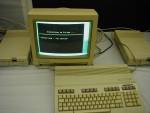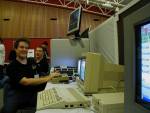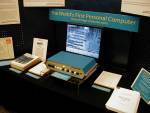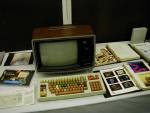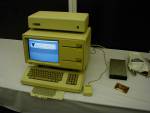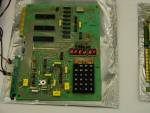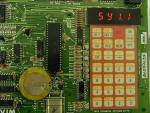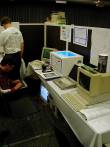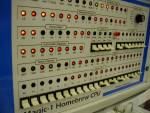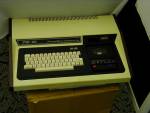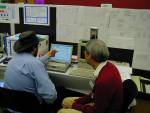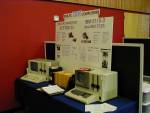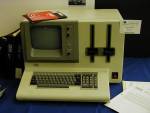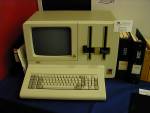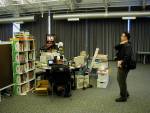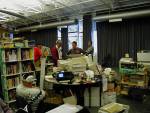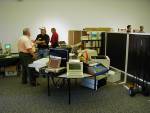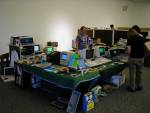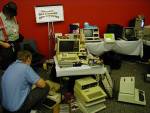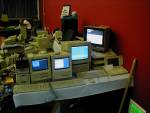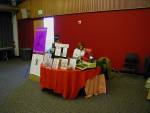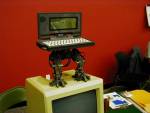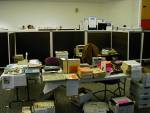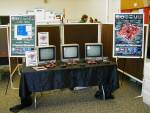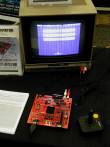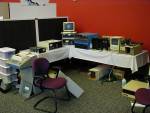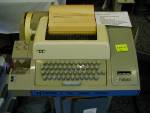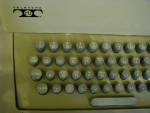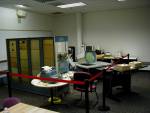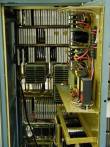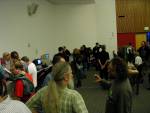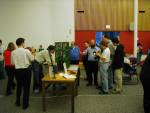VCF 8.0 Nov 5th & 6th 2005
The 2005 West Coast Vintage Computer Festival was November 5th and 6th at the always interesting Computer History Museum (a great place to visit any time you can get the chance!) which is just south of San Francisco Bay in Santa Clara. We (my brother, my wife and I) try to take the trip a day early so we can be rested since we arrive early to set up my exhibit. This trip was cloudy which made for some great pictures of the windmillas at the Altamont pass. The third picture is of the Dishes at Moffett Field near Sunnyvale where we stay at the motel (search for Motel + Mathilda Ave. + Sunnyvale, there are some real reasonable no-frill rates there). Another attraction to the area are the dark squirrels that we saw around Sunnyvale and Mountain View.
note: some of these pictures will make great desktop backgrounds!
This year my display was on connecting Commodore 8-bits to other computers to transfer files (to or from them, such as getting stuff from the internet) as well as converting documents. To keep the display interesting I selected a PET 4016 and an Educator 64 (a Commodore 64 in a PET case) also part of it included a PC, which I specially painted the mouse and keyboard a two-tone black/off white to keep them from clashing with the Commodores. During the show the Educator was quite a point of interest as many had never seen one also having it browse the internet via Retro Replay with RR-Net from Individual Computers with the Contiki Web Browser.
The exhibits a were a little sparse this year, but all were interesting. The other exhibits were [1]Cameron Kaiser's Magic Cap Handheld computers (much smaller one this year, he promises something really interesting next year.) [2]Jordan Ruderman's collection which includes a Lisa, Apple eMate, Apple PowerCD, Exidy Sorcerer and Sol20 (nice to see them all running). [3]Michael Holey's South West Technical Products/Kit Display (also a close up of a project kit which should make a great desktop background[4])
[5]Bill Kendrick had his Atari 8-bit Computers and Games collection. [6]Steven Jones with his AT&T 3B2/500+XM w/ TTY5620 demonstrating various multi user games. [7][8][9]Tim Robinson's Difference Engine #2, which is a re-creation (in progress) of Babbage's second difference engine. The pictures actually do not do it justice as it is truly a marvel to see this machine in action.
There was Robert Armstrong's exhibit of re-creations of the Cosmac Elf (an early RCA hobbiest computer) and PDP-8[10] and next to that was a truly interesting display by Deborah Norling, 1980s Hardware for the Blind Computer User, which showcases many examples of the devices that allow a blind user to compute before there was text to speech software in your OS. (one notable thing about the braille printer is that it is both a printer and a speech synthesiser.)
[14]-[17]Another fascinating display was Leonid Broukhis' exhibit of Soviet Elektronika BK-0010/11m computers. It was interesting to note while these are Soviet machines the programming statements are in English and the error messages are in Russian.
Boris Debic from Google had a real unique exhibit [18][19], it was a do it yourself server rack used by Google in 1999, this was back when rack mounted PCs were not all that common and co-located servers were charged by the square footage. The rack in the picture holds 4 standard Pentium II Motherboards per level and has a total of 80 Linux (2.0) servers per rack. Since they were standard MBs they had to ge creative with things such as wiring and insulation (which was, in this case, cork-board.) The panel shows the server room as well as talks about the fire dangers of doing such a design. (Google is a neighbor to the Computer History Museum BTW).
[20]Evan Koblentz (of Computer Collector Newsletter fame) displayed the Evolution of Handheld Computers from 1973 to 1993, which shows that handheld design and innovation did not start with Apple's Newton (though it did one of the best jobs of putting it together)
I missed getting a shot of Leanord Taylor's exhibit of an Amiga 500 and Atari ST, two amazing computers that probably would have wiped the floor with IBM and Microsoft if it weren't for the their marketing problems. Keith Henrickson wowed many attendees by doing the seeminly impossible with his work on “Quantumlink Reloaded” which is a recreation of the q-link protocol for a modern internet server. Since the early 90s, many people, if they tried to use a Q-Link disk would get the following [21], but with the help of a dedicated Commodore community Kieth an company [22] have connected people together again using the old Q-Disks (and other hardware/emulation via the internet. [23] Even all their graphics for the project were ultra cool (yes, that blur is Robert Bernardo, of FCUG, in the background).
Erik Klien who has brought some amazing computers and loads of support material in past VCFs has wowed me again with a personal computer from (are you ready for this…) 1971! Yes, the Kenback computer [24] was produced in the early 70s and Eric had a prime operational example along with documentation a video of an instructor who used to teach it's operation back in the 70s.
One part of the Exhibit area had two different exhibits, one each day.
On Saturday, Steven Myers displayed his beautiful CompuColor II [25], a very lusted after but expensive color computer from the late 70s (if you though Apples were color rich back then you never saw the CompuColor, if you thought Apples were expensive back then you never saw the CompuColor price tag!) Unfortunately the day before the power supply had a failure so he could not let us see its colorful brilliance. Sunday from out of the blue a lucky lady (don't have her name) showed off a pristine Lisa I [26], now many of you may have seen Apple Lisas in the past, but have you ever seen any with the original 5.25“ “twiggy” disk drives? Besides a dead clock battery it seemed to be working as it was new back in 1983 (and reminds you how slow microcomputer interactive graphics technology was back then) The reason we don't usually see the Twiggy drives is that apple recalled all the original Lisa for a free upgrade to higher capacity 3.5” disks so very few of those drives are known to still exist.
For 6502 fans, Larry Pezzolo had on display Evolution of a Single Board Computer[27], which included the TIM, JOLT, KIM[28], SYM[29] and AIM. Before there was the PET and Apple there were single board computers, where everything was on one board.
And if you think no one builds such computers any more you would have been suprised to see HomebrewCPU: Magic-1, A TTL Minicomputer by Bill Buzbee[30] & [31], Magic-1 is a modern exercise in homebrewing nostalgia. It is a significantly capable homebrew minicomputer wire-wrapped from more than 200 TTL chips, and includes the requisite number of blinky lights on the fully-functional front panel. It features a full ANSI C compiler port and homebrew monitor/OS, an old 20MB 1.3“ HP KittyHawk microdrive for mass storage, user & supervisor modes, hardware address translation and a port of the uIP TCP/IP stack and httpd.
Oh, and you can even play the old Colossal Cave adventure.
Right Next to the Magic-1[31], Hans Franke brought he BastelCard from Germany (he admit's it isn't much, but will have better next year). His exhibit demonstrated a brand new plug-in card for the Apple ][ line of computers. It includes features that will send you back into the days when hardware hacking was something more than adding blue LEDs to your PC case. Hans also was picking up some goodies like the fascinating PMC80 TRS-80 clone [32] (I remember this computer having lots of features at an impossibly low price) and providing some translation assistance to Robert Bernardo of FCUG [33]
Last but not least was Wayne M. Smith with is IBM 5120 and Datamaster.[34] These were among the last machines released by IBM prior to the launch of the IBM PC in the Fall of 1981. The 5120[35] (also know as the 5110 model 3) was the direct descendant of the IBM 5100, and was the last model in that line. The Datamaster[36] shared the 5120's external profile, but inside was a fundamentally different machine. Each of these 100 pound, dual-8 inch drive “desktops” died a quick death once the PC was released.
For those looking for a bargain of vintage hardware, software, or memoribilia, there was plenty of opportunity at the vendors tables Robert Bernardo and friends are regular to many a showing of Commodores was there with the FCUG booth, which included a display of the PAL DTV (version2) for Europe and was selling the new book 'On the Edge: the Spectacular Rise and Fall of Commodore' for author Brian Bagnell. There were a few bits of software and hardware there that I could not leave without. [37]Chief Nerd with the new Commodore Book (autographed too!) is there looking over some pristine boxed software, and here [38]Robert Demos the PAL DTV on a battery powered European TV to an attendee.
Marvin Johnson didn't get as much money from me this year as he forgot his magazines, but he did get some, if you were looking for S-100 computers, Marvin was the man to see who had a wide variety of computers and parts[39] including a SOL-20 as well as an altair era Japanese S-100 computer[40].
Pavl Zachary took time off this year from exhibiting his massive minis to gaining some space and a bit of cash by selling some of the extras from his storage.[41] (The Playskool computer on the floor was tempting, but I already have one at home)
[42][43]Asale Kimaada was there selling a wide range of remarkable micros (including a PET in need of loving attention and a character ROM)
Returning from Last year is artist, Kiel Hoiser and mom [44], who not only was selling prints of anthromorphic computers but had the honor of doing this year's VCF logo aas well as the annual VCF tee shirt art. I really liked this little kit-bashed Atari Portfolio bot.[45]
Stan Seiler had a table full of (I'm sure) wonderful HP stuff[46], that I did not have a clue about..
The Guys at X-Game Station [47][48]were there as well with a more modest booth. but still brings back the excitement of hard coding rasters and loops to make the next videogame hit.
(I missed snapping pictures of Tony Cole's Meorybillia, and Ron Vargas' huge lot 'o Atari (and other) cartridges, software, and SX64 
The last Vendor area was the Consignment area where exhibitors or staff without much to sell could put single systems up for sale.[49] Which included this really nice Teletype ASR-33 terminal with paper tape, which deserved a couple snapshots in itself. [50] [51]
As usual, I missed the conferences this year including the Homebrew Computer Club Reunion which included Steve Wozniac and Lee Felzenstein as panelists (though I did see a lot of things with 'Woz' signatures on them afterwards. I did meet John Draper, AKA Capn' Crunch. Also the wonderful BBS Documentary (by Jason Scott) Screening, but I did get a copy of the DVD (I should asked him to sign it… darn!)
One event I did not miss though was the demonstration of the restored and functional DEC PDP-1 (circa 1960) computer, they had it assembled and running near the front lobby with the original SpaceWar game using retro vintage controllers (but modern buttons), below are some pics of it, BTW: each one of those cards in the cabinet only contains a few transistors, also it was amazingly quiet even with the big fans at the bottom of the cabinet.
To finish up, here are some pictures of [a] various discussions during the public exhibit hours (the guy in the front right of the frame is Dale Luck one of the designers of the Amiga Computer). [b]folks examining the recreation of the Babbage Difference Engine 2, (the guy in the center back is Desmond Crisis, former C|Net reporter who had taped me a few years ago at VCF 3 -IIRC), and finally [c] Sellam Ismael, VCF founder, presenting the exhibit awards, this one was to Deborah Norling for her Bind assistive technology display (best analog technology) I didn't win any this year, but I know my booth was informative and interesting.
Well, that's it for VCF West for 2005, if there is a VCF in your ares (and there are now several around the world), you should think about attending one, or better yet, displaying some of your vintage computers (yeah, it may seem like old-hat to you but there are a lot of people who don't know about the old machines).

